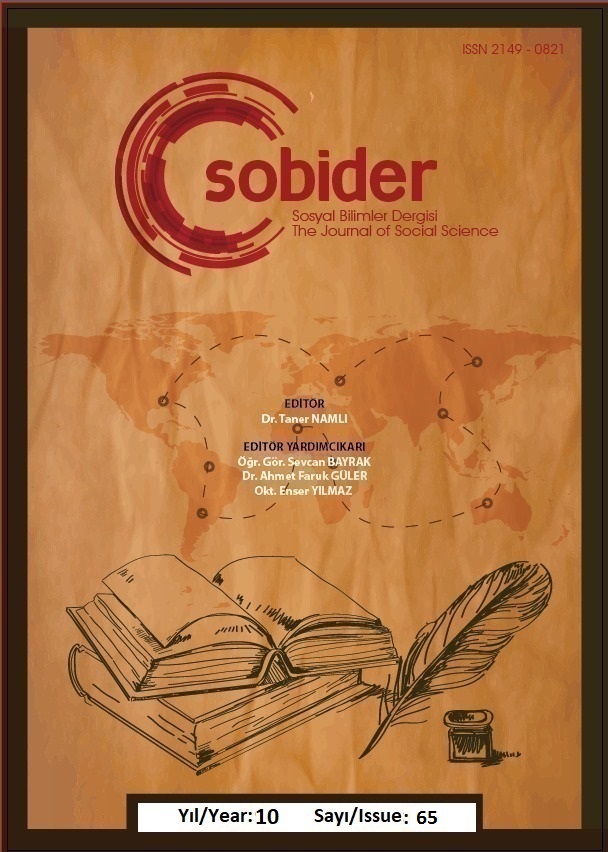Author :
Abstract
Türk resim ve minyatür sanatının Orta Asya’dan başlayarak Anadolu’ya kadar uzanan geniş bir coğrafyada etkili olduğundan söz edilebilir. Orta Asya’dan başlayarak göçler yoluyla Batı’ya doğru yayılan bu sanat, at koşum takımları, eğer süslemeleri, bellemeler ve halı gibi taşınabilir malzemeler üzerine çizilen resimleri temel alarak, etkileşimde bulundukları toplulukların sanatları ile yeni bir sentez oluşturdukları bilinmektedir. En son İslam dininin etkisiyle şekillenen, Anadolu Selçuklu, İran, Ermeni, Bizans gibi medeniyetlerinde etkisiyle Osmanlı resim ve minyatür sanatı olarak şekillenmiştir. Araştırmamızın konusu Türk resim ve minyatür sanatında bir duayen olan Nakkaş Osman’ın hayatı, eserleri ve üslubu üzerinde durulacaktır. Hayatı boyunca 600 den fazla çalışmaya imza atmış dönemin en önemli nakkaşhanelerinde çalışmış ve kendine özgü karakteristik üslubu ile baş nakkaşlığa kadar yükselmiş bir sanatçıdır. Bu çalışmaları ile Osmanlı resim ve minyatür sanatını yabancıların ve Levantenlerin etkisinden uzaklaştırmış, kendine özgü bir üslup geliştirmiştir. Osmanlı minyatür sanatına portre, Sürname gibi birçok yenilik getirmiştir. Başta Hünername olmak üzere yapmış olduğu sayısız minyatür içerisinden Şehzade Mehmet’in Sünnet töreni için yaptığı “Yılan Oynatıcısı”, “Camcıların Geçişi”, “Mimarların Geçişi”, “Bir Aslan’ın Osman Gazi’nin Çizmelerini Yalaması” ve “Ususrcukta Bal Çalanların Cezalandırılması” adlı beş çalışması üzerinde değerlendirecek, sanatçının üslubu ve tekniği üzerinde çözümlemelerde bulunacağız.
Keywords
Abstract
Turkish painting and miniature art can be said to have been influential in a wide geography extending from Central Asia to Anatolia. This art, which started in Central Asia and spread to the West through migrations, is known to have created a new synthesis with the arts of the communities they interacted with, based on paintings drawn on portable materials such as horse harnesses, saddle decorations, bellies and carpets. Finally, it was shaped as Ottoman painting and miniature art with the influence of civilizations such as Anatolian Seljuk, Iranian, Armenian and Byzantine civilizations, which were shaped by the influence of Islam. The subject of our research will focus on the life, works and style of Nakkaş Osman, a doyen in Turkish painting and miniature art. He is an artist who worked in the most important nakkaşhanes of the period with more than 600 works throughout his life and rose to the position of chief nakkaşaş with his own characteristic style. With these works, he moved Ottoman painting and miniature art away from the influence of foreigners and Levantines and developed a unique style of his own. He brought many innovations to Ottoman miniature art such as portraits and Sürname. Among the countless miniatures he made, especially Hünername, we will evaluate five works he made for the circumcision ceremony of Şehzade Mehmet: "The Snake Player", "The Passage of the Glassmakers", "The Passage of the Architects", "A Lion Licking the Boots of Osman Gazi" and "The Punishment of Those Who Stole Honey in Ususrcuk", and we will make analyzes on the artist's style and technique.





